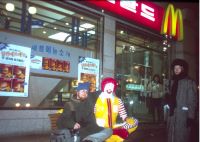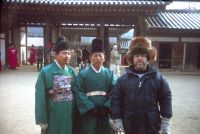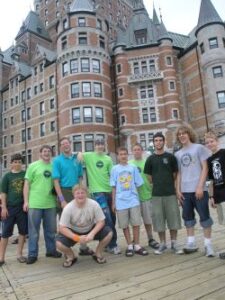Introduction to Fred Hoyt’s travel blog
Although I began the blog in 2008 as an effort to educate participants and their parents, as well as my Scout troop and family, not to mention jogging my memory from time to time….I wish I had started it in the beginning of my meanderings.
They started in 1989, when my son, David, was in Europe—for the third time. I mentioned to my wife that we had always wanted to go to Europe, but we had felt we couldn’t afford it—and we couldn’t afford it because we had been sending him. The logic escaped me.
A little later, she confessed that she had thought about it. The result? “I have tickets so we can join him in Paris for Christmas and New Year’s.”
“But I always go cross country skiing with my troop at that time,” I retorted.
“Which would you rather do?”
“Where should I send you the postcard from Eagle River?”
“You can take the exam as many times as you want until you get it right,” she offered. The third time I got it right.
Paris at Christmas. Midnight mass in Notre Dame, one of the most moving experiences of my life. Christmas ’89 also marked the end of the evil empire. Our hotel was around the corner from the Rumanian embassy, and the anti-Ceausescu crowd besieged the embassy as we watched his fall and execution on the TV. It was exhilarating to see so many places we would read about or had seen in picture books. It stoked my appetite for travel.


There was a trip to China, through IWU, that followed in 1990. I was chosen with Tom Griffiths to accompany an ISU delegation as guests of the China Publication Bureau. The Bureau sent some employees each year to ISU, and in return hosted ISU (and IWU) faculty members. It was a dream come true. China–from Hong Kong to Guangzhou, Kunming, Shanghai, Xian and Beijing. My long-disused  Chinese (3 years at the University of Illinois) returned. I visited places I’d not only read about, but written about in my dissertation. I imagined gunboats at Shanghai, kowtowing to the Emperor in the Forbidden City, or wreaking havoc at the old Summer Palace. An exotic atmosphere marked our trip from Kunming to Dali (home of the Bai nationality. The 11-hour bus ride with academics on the old
Chinese (3 years at the University of Illinois) returned. I visited places I’d not only read about, but written about in my dissertation. I imagined gunboats at Shanghai, kowtowing to the Emperor in the Forbidden City, or wreaking havoc at the old Summer Palace. An exotic atmosphere marked our trip from Kunming to Dali (home of the Bai nationality. The 11-hour bus ride with academics on the old


Burma Road was punctuated with verses of “Hello Dali,” and puns touting the best bais in Dali. By the end of the trip, I understood why the people I had written about in my dissertation, “Americans in China and the Myth of the China Market,” never wanted to come home. I did not either.
An epiphany took place a year or two later, as I sat and mused at the Florida Keys with my Scout troop. The leisure gave me an opportunity to ponder what it meant to be 50. I realized that I had better do what I wanted to do whenever I had the chance. It was as true at 20 as at 50, but I’m glad I had the impetus to seize whatever opportunities I had—and to make some I didn’t have. For the next almost thirty years, I traveled whenever I could. And it started to come down to at least 4 options, as you’ll see in the blogs in this book.
First, the January and then May term trips with Illinois Wesleyan students.




As I said, an opportunity to share my excitement and discovery with 10-25 students for two to three weeks, mixing business with history and culture. What excitement to visit the old foreign enclave in Xiamen, the international settlement at Kulangsu in Amoy, with classical music wafting from crumbling colonial structures, visiting various spots along the
Xiamen, the international settlement at Kulangsu in Amoy, with classical music wafting from crumbling colonial structures, visiting various spots along the


Great Wall, a vain effort to keep the barbarians at bay and to mark the end of the civilized world. We stayed in the Palace Hotel in the former Sasson Building, classic Art Deco of the 193os. The famed Jazz band was back, along with a restaurant on the top floor. When we went there for a meal, I spotted chopsticks with Peace Hotel markings. I was so excited I asked if I could buy a pair. The waiter said 25 yuan (or whatever), took my currency, and went to the next table. He picked up a pair and brought them back. The next 5 pairs were free, since I eliminated the middleman.

 We went to Korea as well, and students were so broke they could not afford to go out of the hotel. However, I had played “Let’s make a deal” with one of our Korean students whose dad was a senior executive with Samsung. He provided us with a guide, a bus, and all the meals we desired, and we went to Panmunjom, Samsung, and the King Sejong grave (he invented the Korean alphabet).
We went to Korea as well, and students were so broke they could not afford to go out of the hotel. However, I had played “Let’s make a deal” with one of our Korean students whose dad was a senior executive with Samsung. He provided us with a guide, a bus, and all the meals we desired, and we went to Panmunjom, Samsung, and the King Sejong grave (he invented the Korean alphabet).
The 1994 visits gradually spread to include other Asian countries, revealing the historical importance of China, and watching the rebirth of the dragon. In 2001—the last trip before 9/11—it was an ambitious venture around the world, via London to New Delhi, to Bangkok, Bali, Saigon, and Hong Kong. Many stops at the airport hotel in Bangkok, since most of the flights were on Thai Air, and routed through the capital of Thailand. May added opportunities to extend the trips and go places I probably wouldn’t take students—such as Mongolia, Tibet, and parts of Eastern Europe.

Second, in my 40 years as Scoutmaster of Troop 19, Best You’ve Seen, a Normal (Illinois) troop that became close to Normal when it moved in 2021 to Bloomington, several of our high adventure trips spilled into excursions. In 1993, coming back from the last hundred miles on the Appalachian Trail in Maine, one of the boys suggested coming back through French Canada. Quebec and Montreal kindled thoughts of Europe—but also of New France, which included the one-time French fort (de Chartres) that marked early settlement in the Illinois Country, and where we had discovered the Rendezvous that provided November and June encampments that became a regular calendar commitment. We also went to the Bahamas sailing, and kayaking and  glacial climbing in Alaska, with a blip into the Yukon territories, which yielded our only bear sighting. The Canadian jaunts increased my understanding of the French/British wars for North America. The Bahamas trips were my initial contact with the Caribbean. We skirted “international” on the St. Croix in Maine in 2019. The river is the boundary between the United States and Canada. On one island, we ate in Canada, and slept in the United States! Those trips are detailed in a separate volume, gifted to me for my 40 years as Scoutmaster.
glacial climbing in Alaska, with a blip into the Yukon territories, which yielded our only bear sighting. The Canadian jaunts increased my understanding of the French/British wars for North America. The Bahamas trips were my initial contact with the Caribbean. We skirted “international” on the St. Croix in Maine in 2019. The river is the boundary between the United States and Canada. On one island, we ate in Canada, and slept in the United States! Those trips are detailed in a separate volume, gifted to me for my 40 years as Scoutmaster.

 The third source of my travels came courtesy (in part) of the US Government. In an effort to educate business people and faculty, the government funded several university outreaches. The Faculty Development in International Business (FDIB) afforded me opportunities to travel with other faculty to explore business and culture in foreign countries. I went on one early to China, Hong Kong, and Bangkok, and realized these would be good preparation for my student trips. The University provided initial funding through a grant, and the trips became addictive. Most were supported by the “Fred Foundation,” investments in knowledge and pleasure. When IWU curtailed my May terms, the FDIB trips to Cuba, Latin America, and Africa expanded my knowledge of international business.
The third source of my travels came courtesy (in part) of the US Government. In an effort to educate business people and faculty, the government funded several university outreaches. The Faculty Development in International Business (FDIB) afforded me opportunities to travel with other faculty to explore business and culture in foreign countries. I went on one early to China, Hong Kong, and Bangkok, and realized these would be good preparation for my student trips. The University provided initial funding through a grant, and the trips became addictive. Most were supported by the “Fred Foundation,” investments in knowledge and pleasure. When IWU curtailed my May terms, the FDIB trips to Cuba, Latin America, and Africa expanded my knowledge of international business.
 Fourth, Carolyn had come on parts of trips with me, sometimes during and sometimes for extended trips afterwards. She was especially intrigued by a Baltic visit as a chaperone to the IWU choir. I promised instead that we would go cruising, and I kept my word. That began over a decade of trips, mostly Europe and the Mediterranean, which culminated in a land tour in March 2020, when Covid and we arrived at about the same time in Spain. She accompanied me on a number of business conference trips, including Viet Nam (shortly after it was opened to foreigners), my 1997 sabbatical to India and Southeast Asia, New Zealand, and China/Korea. In addition, she came to along on some of my student trips.
Fourth, Carolyn had come on parts of trips with me, sometimes during and sometimes for extended trips afterwards. She was especially intrigued by a Baltic visit as a chaperone to the IWU choir. I promised instead that we would go cruising, and I kept my word. That began over a decade of trips, mostly Europe and the Mediterranean, which culminated in a land tour in March 2020, when Covid and we arrived at about the same time in Spain. She accompanied me on a number of business conference trips, including Viet Nam (shortly after it was opened to foreigners), my 1997 sabbatical to India and Southeast Asia, New Zealand, and China/Korea. In addition, she came to along on some of my student trips.
The blogs in these volumes fall into one (or more) of these categories. Some are reminiscences done in 2024-5 when I was compiling these entries.